Wikipedia:Picture of the day/July 2019
|
Featured picture tools: |
These featured pictures, as scheduled below, appeared as the picture of the day (POTD) on the English Wikipedia's Main Page in July 2019. Individual sections for each day on this page can be linked to with the day number as the anchor name (e.g. [[Wikipedia:Picture of the day/July 2019#1]] for July 1).
You can add an automatically updating POTD template to your user page using {{Pic of the day}} (version with blurb) or {{POTD}} (version without blurb). For instructions on how to make custom POTD layouts, see Wikipedia:Picture of the day.Purge server cache
July 1
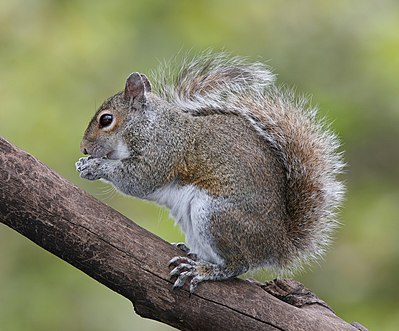
|
The eastern gray squirrel (Sciurus carolinensis) is a tree squirrel in the genus Sciurus, native to the eastern and midwestern United States, as well as to the southerly portions of the eastern provinces of Canada. A prolific and adaptable species, it has been introduced to and thrives in several regions of the western United States; it is also an invasive species in Britain, where it has spread across the country and largely displaced the native Eurasian red squirrel. The head and body can measure from 23 to 30 cm (9.1 to 11.8 in) and the tail from 19 to 25 cm (7.5 to 9.8 in) in length; its adult weight is between 400 and 600 g (14 and 21 oz). Like many members of the family Sciuridae, the eastern gray squirrel is a scatter-hoarder; it hoards food in numerous small caches for later recovery. In the United Kingdom and Canada, the species is simply referred to as the "grey squirrel". This picture, taken in 2010, shows an eastern gray squirrel in Florida. Photograph credit: Tom Friedel |
July 2

|
A collection of garments designed by the Japanese fashion label Comme des Garçons, on display at the Metropolitan Museum of Art in New York City. Founded in 1969 by Rei Kawakubo and established as a company in 1973, the brand's name is inspired by a line from Françoise Hardy's song "Tous les garçons et les filles". It gained popularity in Japan through the 1970s, before making its debut Paris show in 1981, where Kawakubo's heavy use of black, as well as distressed fabrics and unfinished seams, were viewed negatively by critics. Comme des Garçons produced many unusual styles through the 1980s and 1990s, many of which were disliked by experts, but nonetheless grew into a large commercially successful enterprise. The company has boutique stores in several countries, exhibits its main collections annually at the Paris Fashion Week, and also runs a line of perfumes. Photograph credit: Rhododendrites
Recently featured:
|
July 3
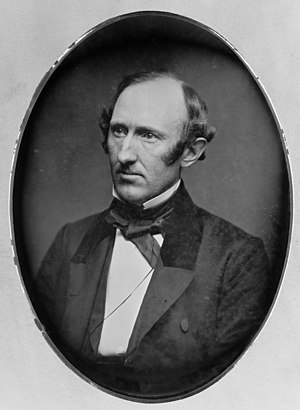
|
Wendell Phillips (1811–1884) was an American abolitionist and advocate for the rights of women and Native Americans. A Boston native, educated at Harvard Law School, he gave up a brief career as a lawyer to become an orator in the anti-slavery movement. He frequently spoke at meetings of the American Anti-Slavery Society and earned the moniker of "abolition's golden trumpet". As an adherent of the free-produce movement, he condemned the purchase of cane sugar and clothing made of cotton, since both were produced by slave labor. Phillips was also an early advocate for women's rights. In the July 3, 1846, issue of The Liberator, he called for securing women's rights to their property and earnings, as well as women's suffrage. He also argued for the creation of a cabinet-level position to secure Native American civil rights, including citizenship, that he believed were granted to them by the Fifteenth Amendment. This picture is a daguerreotype of Phillips in his forties, taken by early American photographer Mathew Brady sometime between 1853 and 1860. The photograph is in the collection of the Library of Congress in Washington, D.C. Photograph credit: Mathew Brady; restored by Yann Forget
Recently featured:
|
July 4

|
|
Back Bay is an officially recognized neighborhood of Boston, built on reclaimed land in the Charles River basin. Construction began in 1859, as the demand for luxury housing exceeded the availability in the city at the time; the area was fully built by around 1900. Back Bay was planned by architect Arthur Gilman, influenced by Haussmann's renovation of Paris. It is noted for its rows of Victorian brownstone homes – considered one of the most preserved examples of 19th-century urban design in the United States – and numerous architecturally significant buildings, as well as cultural institutions, such as the Boston Public Library. Initially conceived as a residential-only area, commercial buildings were permitted from around 1890 and Back Bay now features many office buildings, including the John Hancock Tower, Boston's tallest skyscraper. It is also considered a fashionable shopping destination and is home to several major hotels. Today, along with neighboring Beacon Hill, it is one of Boston's two most expensive residential neighborhoods. In 1973, Back Bay was listed as a historic district on the National Register of Historic Places. This picture is a panoramic view of the Back Bay skyline, taken in 2017, as seen across the Charles River from the Longfellow Bridge. Among the buildings depicted, from left to right, are the Berkeley Building, the John Hancock Tower and the Prudential Tower. Photograph credit: Tony Jin
Recently featured:
|
July 5
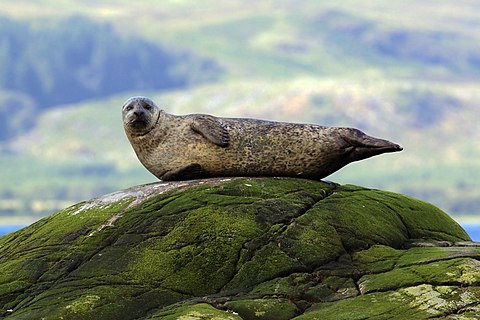
|
|
The harbour seal (Phoca vitulina), also known as the common seal, is a true seal in the genus Phoca, found along temperate and Arctic marine coastlines in the Northern Hemisphere. The most widely distributed species of pinniped, harbour seals are found in coastal waters of the northern Atlantic and Pacific Oceans and the Baltic and North Seas. They are brown, silvery white, tan or grey, with distinctive V-shaped nostrils. An adult can attain a length of 1.85 m (6.1 ft) and a mass of 168 kg (370 lb). Blubber under the seal's skin helps to maintain body temperature. Harbour seals stick to familiar resting spots or haul-out sites, generally rocky areas, where they are protected from adverse weather conditions and predation, near a foraging area. Males may fight over mates underwater or on land. After a nine-month gestation, females bear a single pup, for which they care alone. Pups can weigh up to 16 kg (35 lb) and are able to swim and dive within hours of birth. They develop quickly on their mothers' fat-rich milk and are weaned after four to six weeks. The global population of harbour seals is 350,000 to 500,000, but subspecies in certain habitats are threatened. This picture, taken in 2015, shows a harbour seal off the island of Lismore in Scotland. Photograph credit: Charles J. Sharp
Recently featured:
|
July 6

|
Frida Kahlo (6 July 1907 – 13 July 1954) was a Mexican artist who created many paintings, self-portraits and other works inspired by the nature and artifacts of Mexico. She often featured her own body in her paintings, presenting it in varying states and disguises: as wounded, broken, as a child or clothed in different outfits, such as Tehuana attire, a man's suit or European dress. Kahlo was heavily influenced by Mexicanidad, a romantic nationalism that claimed to resist the "mindset of cultural inferiority" created by colonialism by placing special importance on Mexican indigenous cultures and Aztec mythology. Her paintings also often feature imagery with roots growing out of her body; she developed a complex iconography, extensively employing pre-Columbian and Christian symbols and mythology in her paintings. In most of her self-portraits, she depicts her face as mask-like, but surrounded by visual cues which allow the viewer to decipher deeper meanings from the work. This picture of Kahlo was taken by American photographer Toni Frissell, as part of a 1937 photo shoot for Vogue magazine entitled "Señoras of Mexico". She is depicted outdoors, seated next to an agave plant. The photograph is in the collection of the Library of Congress in Washington, D.C. Photograph credit: Toni Frissell; restored by Adam Cuerden
Recently featured:
|
July 7
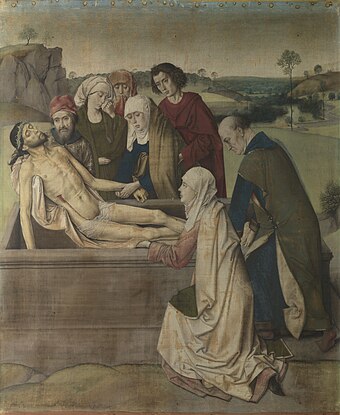
|
The Entombment is a glue-size tempera-on-linen painting attributed to the Early Netherlandish painter Dieric Bouts. It shows a scene from the biblical entombment of Christ and was probably completed between 1440 and 1455 as a wing panel for a large hinged polyptych altarpiece. The now-lost altarpiece is thought to have contained a central crucifixion scene flanked by four wing panel works half its height – two on either side – depicting scenes from the life of Christ. The smaller panels would have been paired in a format similar to Bouts's 1464–1468 Altarpiece of the Holy Sacrament. The larger work was probably commissioned for export to Italy, possibly to a Venetian patron whose identity is lost. The painting is an austere but affecting portrayal of sorrow and grief. It shows four female and three male mourners grieving over the body of Christ. They are, from left to right, Nicodemus, Mary Salome, Mary of Clopas, the Virgin Mary, John the Evangelist, Mary Magdalene and Joseph of Arimathea. The Entombment was first recorded in a mid-19th century Milan inventory and has been in the National Gallery, London, since its purchase on the gallery's behalf by Charles Lock Eastlake in 1861. Painting credit: Dieric Bouts
Recently featured:
|
July 8

|
A view of Josselin Castle, with the Oust river in the foreground. Located in the Morbihan department of Brittany, France, the castle was first built in 1008 by Guéthénoc, viscount of Porhoët, and rebuilt at various times since. The town and castle were named after Guéthénoc's son. The current fortress was built by Olivier de Clisson after 1370; he had acquired the land as dowry on his marriage to Margaret of Rohan. It has been designated as an official historical monument since 1928. Photograph credit: Colin
Recently featured:
|
July 9

|
Chesma (Russian: Чесма, also transliterated Tchésma) was the second ship of the Ekaterina II-class battleships built for the Imperial Russian Navy in the 1880s. Named after the Russian victory at the Battle of Chesma in 1770, she was built by the Russian Steam Navigation Company at Sevastopol. When the ship was completed, she proved to be very overweight, which meant that much of her waterline armor belt was submerged. She served in the Black Sea Fleet until she was turned over to the Sevastopol port authorities and decommissioned in 1907. This chromolithograph print is dated 1892. Print credit: Stadler and Pattinot, after Vasily Ignatius; restored by Adam Cuerden
Recently featured:
|
July 10

|
Gonepteryx rhamni, also known as the common brimstone, is a butterfly in the family Pieridae. It lives throughout the Palearctic zone and is commonly found across Europe, Asia and North Africa. The butterfly relies on two species of buckthorn as hosts for its eggs and larvae, which influences its geographic range and distribution as these plants are commonly found in wetlands. After spending the summer feeding, adults travel to woodland areas to spend seven months hibernating. In spring when their host plants have developed, they return to the wetlands to breed and lay eggs. Both the larval and adult forms of the species have protective coloration and behaviour that decreases their chances of being recognised and preyed upon. The adult common brimstone has sexual dichromism in its wing coloration and iridescence; the male (pictured) has yellow wings and iridescence, while females have greenish-white wings and are not iridescent. Photograph credit: Charles J. Sharp
Recently featured:
|
July 11

|
|
The Catalan Atlas is a medieval map in the Catalan language, created in 1375. Described as "the zenith of medieval map-work", it is the earliest known chart to use a compass rose. It was produced by the Majorcan cartographic school and is attributed to Abraham Cresques, a Jewish book illuminator described by a contemporary as a master of mappae mundi. It has been in the royal library of France (now the Bibliothèque nationale de France) since the time of King Charles V. The atlas originally consisted of six vellum leaves, each about 64.5 by 50 cm (25.4 by 19.7 in), folded vertically and painted in various colours including gold and silver. This picture is a montage of eight pages (four leaves) of the atlas, depicting Europe, northern Africa and Asia. Map credit: Abraham Cresques
Recently featured:
|
July 12

|
Kombat (Russian for 'battalion commander') is a black-and-white photograph by Soviet photographer Max Alpert. It depicts a Soviet military officer, armed with a TT pistol, raising his unit for an attack during World War II. This work is regarded as one of the most iconic Soviet World War II photographs, yet neither the date nor the subject is known with certainty. According to the most widely accepted version, it depicts junior politruk Aleksei Gordeyevich Yeryomenko, minutes before his death on 12 July 1942, in Voroshilovgrad Oblast, now part of Ukraine. The photograph is in the archives of RIA Novosti, a Russian state-owned news agency. Photograph credit: Max Alpert
Recently featured:
|
July 13

|
Wells Cathedral is an Anglican cathedral in Wells, Somerset, commenced around 1175; it is predominantly built in the Early English style. This interior view shows the Lady Chapel, which was begun by Thomas Witney, possibly around 1310. The chapel has an asymmetrical octagonal plan, resulting in a somewhat irregular vault (arched ceiling), which is one of the earliest lierne vaults in England. The main ribs are intersected by non-supporting lierne ribs, which form a star-shaped pattern at the apex. The window tracery is in the Reticulated Gothic style, with a pattern of repeated trefoils, giving a "reticulate" or net-like appearance. Four of the five contain fragments of medieval glass. Photograph credit: David Iliff
Recently featured:
|
July 14

|
The clarinet is a family of woodwind musical instruments, consisting of a single-reed mouthpiece and a straight, cylindrical tube with an almost-cylindrical bore, ending in a flared bell. The instrument has its roots in the early single-reed instruments or hornpipes used in the ancient world. The invention of the modern clarinet is usually attributed to German instrument-maker Johann Christoph Denner, who developed it from a Baroque instrument called the chalumeau around 1700. The instrument became popular in orchestral pieces, including numerous compositions by Mozart; by the time of Beethoven (c. 1800–1820), the clarinet was a standard fixture in the orchestra. The clarinet family includes instruments in many different pitches, the most common of which are the soprano clarinets in B♭, A and C. This picture shows a 22-key B♭ clarinet using the Oehler fingering system, with a 56 mm (2.2 in) diameter barrel. The body of the instrument is made of grenadilla and the keys of silver-plated nickel silver. Photograph credit: Yamaha Corporation
Recently featured:
|
July 15

|
Rembrandt (15 July 1606 – 4 October 1669) was a Dutch draughtsman, painter and printmaker. An innovative and prolific master in three media, he is generally considered one of the greatest visual artists in the history of art and the most important in Dutch art history. Unlike most Dutch masters of the 17th century, Rembrandt's works depict a wide range of style and subject matter, from portraits and self-portraits to landscapes, genre scenes, allegorical and historical scenes, biblical and mythological themes, as well as animal studies. His contributions to art came in a period of great wealth and cultural achievement that historians call the Dutch Golden Age, when Dutch art (especially Dutch painting), although in many ways antithetical to the Baroque style that dominated Europe, was extremely prolific and innovative, giving rise to important new genres. Like many artists of the period, such as Johannes Vermeer, Rembrandt was also an avid art collector and dealer. This picture is an oil-on-canvas painting, entitled Self-Portrait at the Age of 63, painted by Rembrandt in 1669, the year of his death. It was the last in his long series of self-portraits. The painting is now in the collection of the National Gallery in London. Painting credit: Rembrandt
Recently featured:
|
July 16

|
The Saturn V SA-506 carrying Apollo 11, the first crewed lunar landing mission, on July 16, 1969, at 13:32 UTC. Launching from Launch Pad 39A at Florida's Kennedy Space Center, the five Rocketdyne F-1 engines of the rocket's S-IC first stage can be seen arrayed in a quincunx, with a fixed center engine and four outer engines that gimballed for steering. A multistage liquid-fuel expendable launcher, the Saturn V was designed under the direction of Wernher von Braun at the Marshall Space Flight Center. It was the largest production model of the Saturn family, with a height of 111 m (363 ft), although larger models were theorized. The super heavy-lift launch vehicle consisted of liquid-propellant rockets in three stages, the first of which had a total mass at launch of 2.3 million kilograms (5.1 million pounds), consisting mostly of its RP-1 fuel and liquid oxygen. As well as launching Apollo missions, the Saturn V also launched the Skylab space station. Thirteen rockets were launched from 1967 to 1973, with an almost perfect launch record – Apollo 6 and Apollo 13 did lose engines, but the onboard computers were able to compensate. Photograph credit: NASA; retouched by PawełMM
Recently featured:
|
July 17
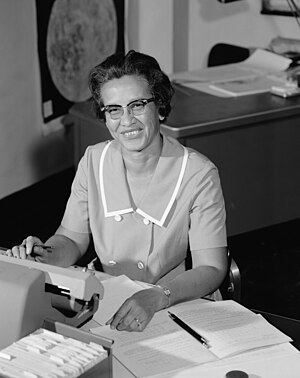
|
Katherine Johnson (born 1918) is an African-American mathematician whose calculations of orbital mechanics as a NASA employee were critical to the success of U.S. crewed spaceflights. During her 35-year career at NASA and its predecessor, the National Advisory Committee for Aeronautics, she earned a reputation for mastering complex manual calculations and helped the space agency pioneer the use of computers to perform tasks. She worked on the calculation of trajectories, launch windows and emergency return paths for Project Mercury spaceflights, including those of Alan Shepard and John Glenn, respectively the first Americans in space and in orbit. Johnson later worked with the Apollo program, calculating rendezvous paths for the lunar lander and command module on its flights to the Moon. Her calculations were essential to the beginning of the Space Shuttle program and she also worked on plans for a mission to Mars. In 2015, President Barack Obama awarded her the Presidential Medal of Freedom, as a pioneering example of African-American women in STEM. She was portrayed by Taraji P. Henson as a lead character in the 2016 film Hidden Figures. This picture, taken in 1966, shows Johnson at her desk at Langley Research Center. Photograph credit: NASA; restored by Adam Cuerden |
July 18
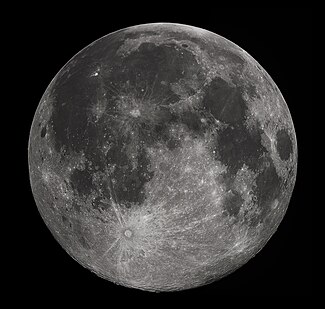
|
The Moon is the only natural satellite of Earth and the fifth largest moon in the Solar System. Owing to its synchronous rotation around Earth, the Moon always shows essentially the same face: its near side, which is marked by dark volcanic maria, as well as the bright ancient crustal highlands and the prominent impact craters. However, variations in the Moon's orbital speed due to its orbital eccentricity cause a libration of several degrees of longitude; the alignment of the Moon's orbital plane causes a similar libration in latitude. The Moon was first reached in September 1959 by the Soviet Union's unmanned Luna 2, followed by the first successful soft landing by Luna 9 in 1966. The United States Apollo program achieved the only manned lunar missions to date, including Apollo 8 in 1968, the first manned orbital mission, as well as Apollo 11, the first of six manned landings between 1969 and 1972. This picture shows the near side of the Moon close to its greatest northern ecliptic latitude, so the southern craters are especially prominent. Tranquility Base, Apollo 11's landing site, is located near the mid-right in the photograph. Photograph credit: Gregory H. Revera
Recently featured:
|
July 19

|
Margaret Hamilton (born 1936) is an American computer scientist, systems engineer and business owner. She was director of the Software Engineering Division of the MIT Instrumentation Laboratory, which developed on-board flight software for NASA's Apollo space program. In 1986, she founded Hamilton Technologies, Inc., in Cambridge, Massachusetts. The company was developed around Universal Systems Language, based on her paradigm of "Development Before the Fact" for systems and software design. Hamilton has published over 130 papers, proceedings and reports about sixty projects and six major programs. She is one of the people credited with coining the term "software engineering". In 2016, she received the Presidential Medal of Freedom from President Barack Obama for her work leading to the development of on-board flight software for NASA's Apollo missions. This picture, taken in 1969, shows Hamilton standing next to listings of the navigation software that she and her team at MIT produced for the Apollo project. Photograph credit: Draper Laboratory; restored by Adam Cuerden
Recently featured:
|
July 20

|
The Parkes Observatory is a radio telescope observatory in New South Wales, Australia, located 20 kilometres (12 mi) north of the town of Parkes. It was one of several radio antennae used to receive live television images of the Apollo 11 Moon landing on 20–21 July 1969. Its scientific contributions over the decades has led the Australian Broadcasting Corporation to describe it as "the most successful scientific instrument ever built in Australia" after 50 years of operation. The observatory, which opened in 1961, is run by the Commonwealth Scientific and Industrial Research Organisation (CSIRO), an independent Australian federal government agency, as part of the Australia Telescope National Facility network of radio telescopes. It is frequently operated together with other CSIRO radio telescopes to form a very-long-baseline interferometry array. This picture, taken in 1969, shows the Parkes Observatory's main 64-metre (210 ft) diameter radio telescope dish, around the time that it received transmissions from Apollo 11, with a crescent moon visible in the background. The photograph is part of CSIRO's ScienceImage archive. Photograph credit: CSIRO
Recently featured:
|
July 21

|
Apollo 11 was the fifth crewed mission of NASA's Apollo program. After launching from the Kennedy Space Center in Florida on July 16, 1969, commander Neil Armstrong and Apollo Lunar Module pilot Buzz Aldrin landed Eagle in Mare Tranquillitatis on July 20, at 20:17:40 UTC, while command module pilot Michael Collins remained on Columbia in lunar orbit. Armstrong was the first to exit the spacecraft, stepping onto the surface 6 hours and 39 minutes later, on July 21, at 02:56:15 UTC; nineteen minutes later, Aldrin joined him on extravehicular activity, which lasted 2 hours, 31 minutes and 40 seconds. Armstrong and Aldrin lifted off from Tranquility Base after almost 22 hours on the lunar surface and rejoined Collins in the command module, before splashing down in the Pacific Ocean on July 24. The mission was planned to the minute, with the majority of the photographic tasks performed by Armstrong with a single Hasselblad camera. Most of the photographs taken on the Moon that include an astronaut are of Aldrin; there are only five images of Armstrong partly shown or reflected, as in this photograph, with Armstrong and the lunar module reflected in Aldrin's helmet visor. "As the sequence of lunar operations evolved," Aldrin explained, "Neil had the camera most of the time [...] It wasn't until we were back on Earth and in the Lunar Receiving Laboratory looking over the pictures that we realized there were few pictures of Neil." Photograph credit: Neil Armstrong
Recently featured:
|
July 22

|
|
Mary Jackson (1921–2005) was an African American mathematician and aerospace engineer at the National Advisory Committee for Aeronautics, which was succeeded by NASA in 1958. For most of her career, she worked at Langley Research Center in Hampton, Virginia; starting as a computer at the segregated West Area Computing division, she later took advanced engineering classes and, in 1958, became NASA's first black female engineer. After 34 years at NASA, Jackson had earned the most senior engineering title available. Realizing that she could not earn further promotions without becoming a supervisor, she accepted a demotion to become a manager of the Federal Women's Program in the NASA Office of Equal Opportunity Programs, as well as of the Affirmative Action Program. In this role, she worked to influence both the hiring and promotion of women in NASA's science, engineering and mathematics careers. She was portrayed by Janelle Monáe as a lead character in the 2016 film Hidden Figures. This picture, taken in 1980, shows Jackson working at NASA Langley. Photograph credit: Langley Research Center; restored by Adam Cuerden
Recently featured:
|
July 23

|
|
Canis Major (Latin for 'greater dog') is a constellation in the southern hemisphere's summer sky and the northern hemisphere's winter sky. In the second century, it was included in Ptolemy's 48 constellations and is counted among the 88 modern constellations. Along with Canis Minor, it is commonly represented as following the constellation of Orion, the hunter, through the skies. The Milky Way passes through Canis Major. Several open clusters lie within its borders, including M41, which covers an area around the same size as the full moon. Canis Major contains Sirius, also known as the "dog star", the brightest star in the night sky and one of the closest stars to Earth. The other bright stars in the constellation are much farther away but very luminous. At magnitude 1.5, Epsilon Canis Majoris (Adhara) appears as the second brightest star of the constellation and is the brightest source of extreme ultraviolet radiation in the night sky. Next in brightness are the yellow-white supergiant Delta (Wezen), at magnitude 1.8, the blue-white giant Beta (Mirzam), at magnitude 2.0 and the blue-white supergiant Eta (Aludra), at magnitude 2.4. The red hypergiant VY Canis Majoris is one of the largest known stars, while the neutron star RX J0720.4−3125 has a radius of a mere 5 km (3 mi). This illustration, which also features the constellations Lepus, Columba Noachi (now Columba) and Cela Sculptoris (now Caelum), was produced around 1823 and comes from Urania's Mirror, a set of 32 astronomical star chart cards. Lithograph credit: Sidney Hall; restored by Adam Cuerden
Recently featured:
|
July 24

|
The Sun is the star at the center of the Solar System. It is a nearly perfect sphere of plasma, heated by nuclear fusion of hydrogen into helium in its core, with internal convective motion that generates a magnetic field via a dynamo process. It is by far the most important source of energy for life on Earth. Its diameter is about 1.39 million kilometres (860,000 miles) or 109 times that of Earth, while its mass is about 330,000 times that of Earth. It accounts for about 99.86% of the total mass of the Solar System. Roughly three-quarters of the Sun's mass consists of hydrogen; the rest is mostly helium, with much smaller quantities of heavier elements, including oxygen, carbon, neon and iron. This false-color photograph of the Sun was taken by the Atmospheric Imaging Assembly instrument on NASA's Solar Dynamics Observatory (SDO) at a wavelength of 304 angstroms, in the extreme ultraviolet region of the electromagnetic spectrum.
Recently featured:
|
July 25

|
The baptism of Jesus is one of the five major milestones in the gospel narrative of the life of Jesus, the others being the transfiguration, the crucifixion, the resurrection and the ascension. It is described in the gospels of Matthew, Mark and Luke. John's gospel does not directly describe Jesus's baptism. Most modern theologians view the baptism of Jesus by John the Baptist as a historical event to which a high degree of certainty can be assigned. Along with the crucifixion, most biblical scholars view it as one of the two historically certain facts about him and often use it as the starting point for the study of the historical Jesus. This picture is a tempera-on-poplar painting titled The Baptism of Christ, produced by Italian painter Piero della Francesca sometime after 1437. It is in the collection of the National Gallery in London. Painting credit: Piero della Francesca
Recently featured:
|
July 26

|
New York is a state in the Northeastern United States, one of the original Thirteen Colonies. It was the 11th state to be admitted to the Union, on July 26, 1788. With an estimated 19.54 million residents in 2018, it is the fourth most populous state; the state's most populous city, New York City, makes up over 40% of the state's population. The state and the city were both named for the 17th-century Duke of York, later King James II of England. Albany, in Upstate New York, is the state capital. This picture is a historical depiction of New York's coat of arms, as illustrated by American engraver Henry Mitchell in State Arms of the Union, published in 1876 by Louis Prang. The escutcheon depicts the Hudson River, with the sun rising behind a mountain range in the background, while the crest features a globe surmounted by a bald eagle. The supporters are personifications of Liberty on the left and Justice on the right. Below the shield is the Latin motto Excelsior, commonly translated as 'Ever upward'. This design also appears on the flag and the seal of New York. Illustration credit: Henry Mitchell; restored by Andrew Shiva
Recently featured:
|
July 27

|
Edward Montagu, 1st Earl of Sandwich (27 July 1625 – 28 May 1672), was an English landowner and infantry officer who later became a naval officer and a politician who sat in the House of Commons at various times between 1645 and 1660. He served Oliver Cromwell loyally in the 1650s, but went on to play a considerable part in the Restoration of King Charles II and was rewarded with several court offices. Sandwich served as the English ambassador to Portugal from 1661 to 1662 and the ambassador to Spain from 1666 to 1668. He later became an admiral, serving in the two Anglo-Dutch Wars during the reign of Charles II; he was killed at the Battle of Solebay. A detailed primary source for Sandwich's career in the 1660s is the diary of Samuel Pepys, who was his cousin and protégé. This picture is an oil-on-canvas portrait of Sandwich by Sir Peter Lely, an English painter of Dutch origin, dated around 1660 to 1665. He is depicted in the robes of the Order of the Garter, into which he was inducted as a knight by Charles II. The painting is in the collection of the Yale Center for British Art in New Haven, Connecticut. Painting credit: Peter Lely
Recently featured:
|
July 28

|
The village weaver (Ploceus cucullatus) is a species of bird in the family Ploceidae found in much of sub-Saharan Africa. It has also been introduced to Hispaniola, Mauritius and Réunion. This often abundant species occurs in a wide range of open or semi-open habitats, including woodlands and human habitation, frequently forming large noisy colonies in towns, villages and hotel grounds. The species builds a large coarsely woven nest made of grass and leaf strips with a downward facing entrance, suspended from a branch in a tree. Two to three eggs are laid. Village weavers are colonial breeders, so many nests may hang from one tree. This picture shows a female P. c. cucullatus individual in the Tanji Bird Reserve, The Gambia. Photograph credit: Charles J. Sharp
Recently featured:
|
July 29

|
Vincent van Gogh is an oil-on-canvas portrait by Australian painter John Russell, dated 1886. It depicts Dutch artist Vincent van Gogh, who became lifelong friends with Russell after meeting him at Fernand Cormon's atelier in Paris, which they both attended. Painted in a realist and academic manner, the portrait shows hints of the impressionist techniques with which they began experimenting in the latter half of the 1880s. It is the earliest of three portraits painted of Van Gogh by his contemporaries, the other two being Henri de Toulouse-Lautrec's Portrait of Vincent van Gogh (1887) and Paul Gauguin's The Painter of Sunflowers (1888). Van Gogh seems to have been particularly attached to Russell's portrait, which Russell gifted to him as a mark of their friendship. The painting passed from Van Gogh to his brother Theo and then to their family; it is now in the collection of the Van Gogh Museum in Amsterdam. Painting credit: John Russell
Recently featured:
|
July 30

|
Venkatraman Ramakrishnan (born 1952) is an Indian-born American-British structural biologist. After graduating with a degree in physics in 1971, he moved to the United States, where he obtained a PhD in physics in 1976. He then spent two years studying biology as a graduate student while making a transition from theoretical physics to biology, beginning work on ribosomes as a postgraduate fellow at Yale University. In 1999, Ramakrishnan's laboratory published a 5.5-angstrom resolution structure of the 30S subunit of the ribosome. The following year, his laboratory determined the complete molecular structure of the 30S subunit and its complexes with several antibiotics. Ramakrishnan was awarded the 2009 Nobel Prize in Chemistry along with Thomas A. Steitz and Ada Yonath "for studies of the structure and function of the ribosome". He was elected President of the Royal Society for a term of five years beginning in 2015. Since 1999, he has worked as a group leader at the UK Medical Research Council's Laboratory of Molecular Biology at the Cambridge Biomedical Campus. Photograph credit: Royal Society
Recently featured:
|
July 31
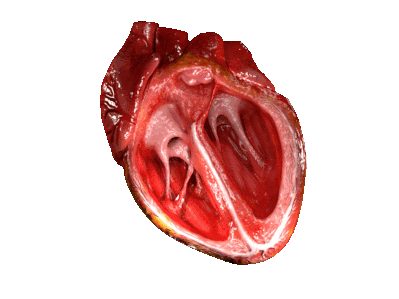
|
A computer-generated animation showing the cardiac cycle, which is the performance of the human heart from the ending of one heartbeat to the beginning of the next. It consists of two periods: one during which the heart muscle relaxes and refills with blood, called diastole, followed by a period of robust contraction and pumping of blood, known as systole. After emptying, the heart immediately relaxes and expands to receive another influx of blood returning from the lungs and other systems of the body, before again contracting to pump blood to the lungs and those systems. A normally performing heart must be fully expanded before it can efficiently pump again. Assuming a healthy heart and a typical rate of 70 to 75 beats per minute, each cardiac cycle or heartbeat takes about 0.8 seconds to complete. Animation credit: Doctor Jana
Recently featured:
|
Picture of the day archives and future dates
